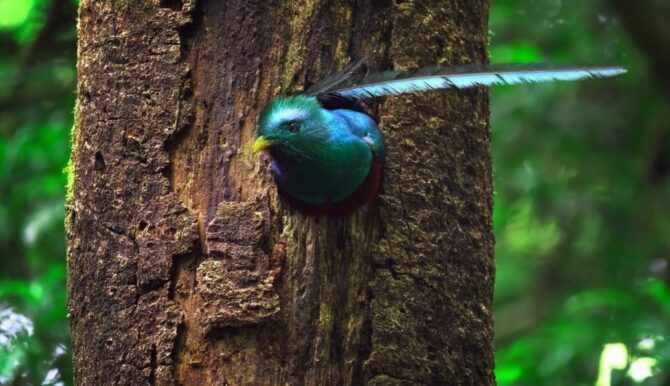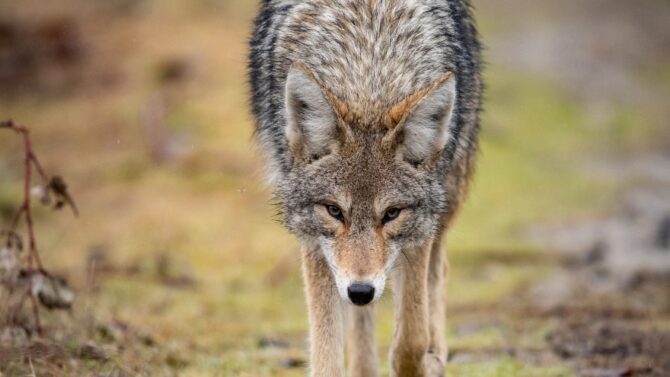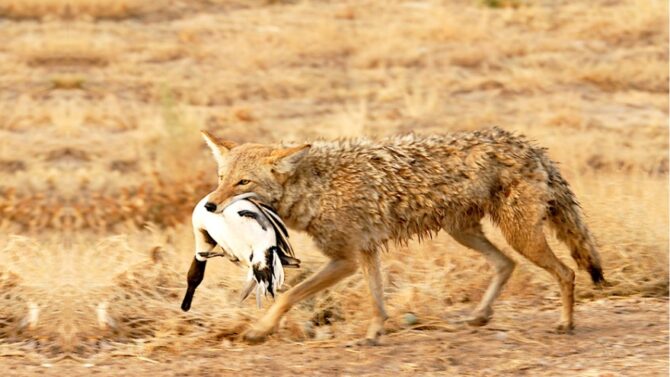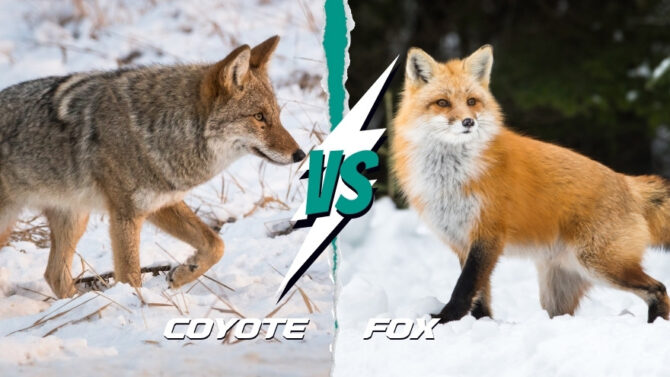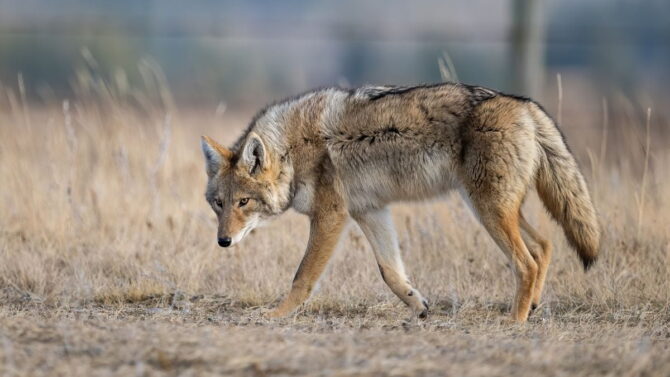The coyote is a member of the Canidae (dog) family and is a relative of the wolf and the jackal.
There are 19 recognized subspecies, and this canid is widespread across North America. It is even considered one of the most common mammals in North America.
Similar to the fox, the coyote has often been a character in folklore, but not in a good light.
There is generally a negative perception of these animals, and though they are not highly dangerous, they seem to have more haters than fans.
The coyote had its own story to tell, however, and we’ll be relaying that to you. Here’s the profile of this cunning creature.
Scientific Classification
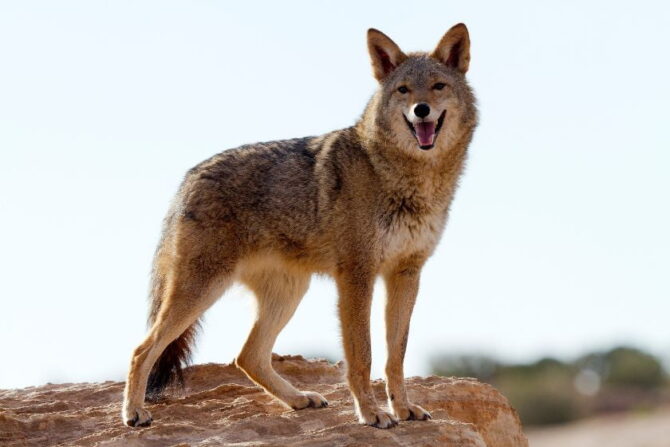
| Kingdom | Animalia |
| Phylum | Chordata |
| Class | Mammalia |
| Order | Carnivora |
| Family | Canidae |
| Genus | Canis |
| Species | C. latrans |
| Binomial Name | Canis Latrans |
Characteristics
| Length | 30 to 35 inches |
| Weight | 15 to 46 pounds |
| Venom/Poison | No |
| Skin Type | Fur |
| Habitat | Forests, plains, deserts |
| Range | North America |
| Diet | Omnivore (Main prey: Rabbit, mice, deer) |
| Life span | 10 to 15 years |
| Gestation Period | 60 to 63 days |
| Conservation status | Least Concern |
Interesting Facts About Coyotes
1. They live in cities
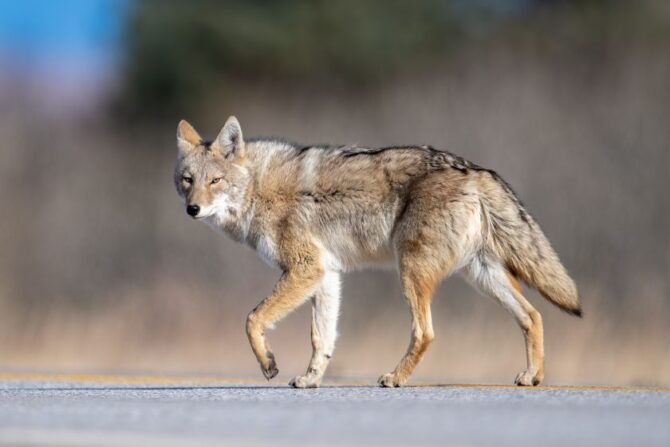
While found mainly in the wild, coyotes can find themselves in urban environments.
This proximity to humans is probably a result of habitat loss, forcing the canids to get a place to live.
This is also possible because they aren’t too dangerous. Their presence in cities won’t be reducing anytime soon.
Individuals in urban cities seem to show different behaviors from those in the wild and rural areas.
They are less wary of humans, may be threatening to your pets, and eat human food.
A challenge with these animals living in cities is that people feed them. This reduces the wariness towards humans but also increases the likelihood of an attack.
2. They help in controlling pests
Having rodent issues? Call a coyote! Seriously, though, it is adept in hunting down rodents, a much-needed skill if your environment has been overtaken by vermins. These canids can be useful in that aspect.
However, not everyone fancies having wild dogs around them, even if they reduce the mice population.
There are safe ways you can remove them from your property.
3. They are fast
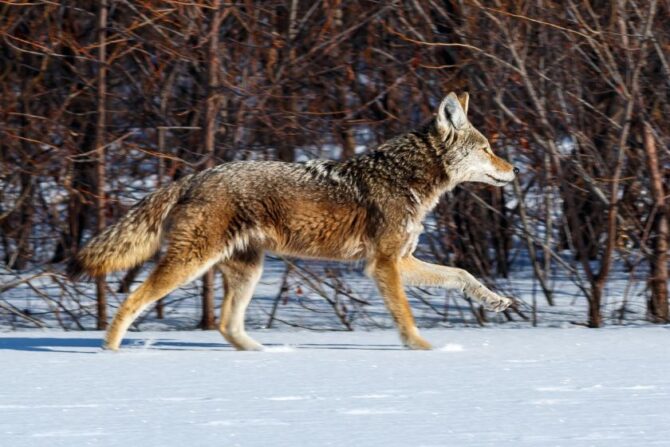
Coyotes have a slim figure that enables them to move with speed and climb heights. While they don’t run a lot, they’re fast when they do.
This often happens when they’re pursuing prey or running away from danger.
Their speed gets up to 43 mph, making them faster than a domestic dog, cat, and Usain Bolt. Their speed is similar to a racing greyhound, and they are even faster than wolves!
A cool thing about these animals is that you may never hear them run. They are light on their feet and often move on tiptoes. You need to guide your pets away from the coyote.
4. They eat fruit and grass
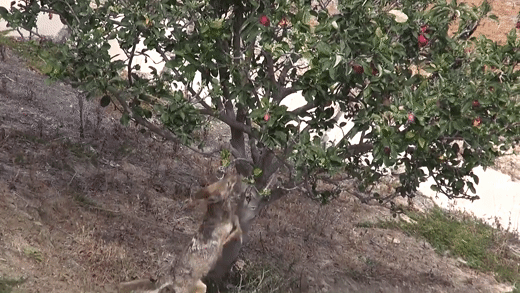
Though they fall under the Carnivora order, coyotes can eat plant-based food like fruits, berries, and vegetables.
This is why one can classify them as an omnivore rather than pure carnivores as canids usually are.
Their diet consists more of animals than plants, a nod to their carnivorous roots.
However, they have the advantage of being highly adaptable, which expands their diet.
5. It has other names and is a part of folklore
Besides being called a coyote, this wild dog is also called the prairie wolf or the brush wolf.
It was also once termed the American Jackal. However, people don’t always recognize it by these names.
It is also a part of folklore, especially that of America. Depicted as a cunning figure and a shapeshifter, the coyote is the definition of a trickster.
This might explain the generally negative perception the public has.
General Description

The coyote’s scientific name is Canis latrans, a Latin word that can be translated loosely as a barking dog.
This sets the first attribute of this canid. It is a ‘barking dog’. The name “coyote” has its roots in Spain.
There are 19 subspecies, all of which fall in different locations. They include Honduras, Mexican, the Californian valley coyotes, and many others. There aren’t many differences between these subspecies.
The wolf, dingos, jackals, and dogs belong to the same genus as this species. Thus, the latter can be mistaken for a small wolf.
It has perky ears, yellow eyes, and a floppy tail. Its coat comes in colors like grey, brown, yellow, and red, found in different parts of the body.
The coat is coarse on the outside but soft underneath. Color may vary based on the subspecies and the environment.
Coyotes shed around once a year, and this process enables them to get a completely new coat. Shedding often occurs during summer when they get rid of dead hair.
According to evolutionary theory, coyotes evolved in the past million years or so. This is evidenced by fossils.
The modern version may have come about during the ice age when large animals got extinct.
They probably adapted to become smaller than wolves due to competition.
Coyote Distribution and Habitat
This animal faces no threat of extinction, and under the IUCN it is classified as “least concern”. Its adaptability is often cited as the main reason for the increase in population, despite the high rate of mortality.
That said, the coyote is not widespread. In continents like Africa, there are no known traces of this creature.
It can only be found in North and Central America, where it is abundant to the extent of being considered a pest.
The expansion hasn’t stopped, and this animal might soon get into South America.
Countries, where the coyote resides, include Canada, the United States, and Mexico.
In these countries, it inhabits mountains, forests, swamps, plains, deserts, rainforests, and urban dwellings alongside humans.
Behavior
Coyotes are not solitary animals, but they don’t have a well-defined social system like wolves do. A group is usually a family unit that consists of a male, female, and pups.
However, there are also non-family, temporary groups formed for hunting or just companionship. If they can’t find such groups and don’t have a family, they may hunt alone.
These are very vocal mammals, taking advantage of different sounds to communicate. They also use body language and scent signals.
All the forms of communication can serve to warn, greet other individuals or signal the presence of prey if they’re in a group.
The scent is important for these folks, and it influences how they mark territories. They urinate as a ‘signature’ to others, and these others pick up the scent.
Like other dogs, the concept of dominance is real amongst coyotes. Individuals get into fights to establish their dominance.
Here, body signals work. A low posture is a sign of submission, for instance.
Coyote Diet
Many people might mistake the coyote as a carnivore because of its relationship with wolves, but its dietary needs are closer to the fox. It eats both animals and plants, both of which can be found in its habitats.
All subspecies seem to prioritize animals over plants, preying on rabbits, mice, and deer. They also hunt down pets and livestock, making them even more of a nuisance.
Their plant-based diet consists of fruits, berries, and vegetables. They would resort to these plants when animal prey is scarce or when they find the opportunity.
The same applies to human leftovers. It isn’t uncommon for urban coyotes to ravage waste bins.
These animals love to hunt and would prefer eating live animals. They hunt more in packs, which enables them to take down prey bigger than they are.
This doesn’t stop them from being scavengers, however. They can feast on dead animals if possible.
Reproduction and Mating Process
Coyotes are generally monogamous and stay for a lifetime, though not always.
There is no evidence of polygamy in this species, so one can expect a ’till death do you part’ even when there are other mating partners.
Monogamy is beneficial due to survival. The female has a short heat period that lasts for a few days, so the time is best spent reproducing than looking for a mate.
Breeding often falls between January and March, and it is during this period coyotes mate.
They get stuck during the process for as long as 20 minutes, which is often known as a ‘lock’.
Shortly after that, the female digs a den or finds a good place where she can give birth.
Females carry the pup for around 2 months, then she gives birth in the safe space she has created.
The litter could go from 6 to as many as 19. The duty of the male during this period is to keep guard as the female often gives birth alone.
He also provides food for the female. She could remain in the den for as long as a week.
Both parents have a hand in taking care of the pups, who are very vulnerable at that age.
The pups are blind, small, and have a low chance of survival. They depend on their parents to grow.
After a month, the pups get weaned. They remain dependent on their parents for 6 or 9 months.
Independence for this species is like what you’d expect from a traditional human society.
The males leave to survive on their own while females remain with their parents, sometimes even pups sitting with other offspring.
Coyote Predators and Threats
Coyotes are not apex predators, but they don’t have many enemies.
They’re swift and able to defend themselves against any predator. However, some animals consider this canid a part of their diet.
These include bears, alligators, cougars, and wolves. It isn’t easy to prey on a coyote, so the latter isn’t the first choice for big predators.
This is especially true with healthy individuals. It is easier to take out an injured one.
Rather than being direct predators, these bigger animals are usually competition. They would drag for food with the coyote, and in many cases win.
These bigger predators have the advantage of size, putting our canid friend at risk of not getting enough to feed on.
A big threat these animals face comes from humans. They are susceptible to human hunting, either for entertainment or out of retaliation.
It is estimated that over 400,000 are killed each year. Urban coyotes may also fall victim to car accidents and other related dangers.
Male vs Female
The sex differences in the species aren’t much, but you can tell if you know what to look for.
You’d have to draw closer to distinguish them, because from afar they may look the same. If you’re observing the wildlife, you could go with binoculars.
Males tend to be bigger than females, so if two coyotes are together, the bigger one may be the male. He is heavier as well, except when the female is pregnant.
Another factor to look out for is behavior. Males tend to be more aggressive, and solitary individuals are usually masculine.
If you happen to witness their mating, it is easy to know the male. Whoever’s mounting is a dead giveaway.
It may not be easy to check the genitalia when facing living creatures, but this is a sure way to pick up the sex.
Frequently Asked Questions
What is the difference between a coyote and a wolf?
The major difference between a coyote and a wolf is the size. The wolf is bigger, almost like the eldest brother between the two. Their social system slightly varies too. The wolf forms strong packs, but the coyote has a more flexible system.
How many coyotes are there in the world?
This animal is centered more in North America, where it is very common. There is no precise estimate of the coyote population, but it is enough to be classified as “Least Concern” despite its narrow range.
Can coyotes be domesticated?
Coyotes are intelligent and many seem to be losing their fear of humans. However, they can’t be domesticated as they can’t recognize and follow commands as dogs do.
Is the coyote dangerous?
These animals aren’t considered highly dangerous to humans and are more likely to be just a nuisance. However, there have been a few cases of attacks from them.
Final Thoughts
Coyotes are more than tricksters in folklore. This is an intelligent canid with a penchant for monogamy, and with a high level of adaptability.
While you can’t get one as a pet (and you shouldn’t), they are fun to observe and learn from.
